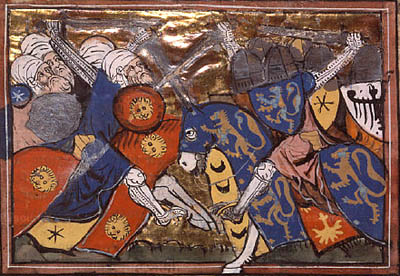 |
The Saint of the Day
St. Callistus of Huesca – October 15
Prof. Plinio Corrêa de Oliveira
Biographical selection:
St. Callistus of Huesca was a valorous Spanish officer who became famous for his fight against the Moors in Aragon. He lived in the 10th century and died in 1003.
To assist the inhabitants of Aure valley in France against the enemies of Christianity, he and his companion, in arms St. Mercurialis, went there to defend them. Both died in combat. The Diocese of Tarbes, France, celebrates his feast day on October 15.
Comments of Prof. Plinio:

Combat between Catholic knights and Saracens
Miniature of Godefroy Bouillon, 1337
|
At that time, the fight against the Saracens was still in its epic period when they were a great power that had not been virtually defeated. The Spanish Reconquista was just starting to give its great fruits, but at that time the future was uncertain.
In this period we see two military saints who fought side by side against the Moors. Because of their combativeness these two heroes were screened out of certain Books of Saints and hidden by that Sulpician sentimental school of piety that adulterates the lives of the saints by presenting only their soft and delicate facets. This is why almost no one knows about them. I am glad to comment on them to repair this flaw and fill the vacuum.
We can imagine the marvelous scene. On the top of a mountain the two saints are fighting together outnumbered by a large horde of Saracens. The sun is beginning to set and the last rays of its light shine on their metal armor and swords. A golden dusk covers the battle that ensues amidst a great clamor of weapons and shouts.

One can imagine the death of the valiant Catholic warrior St. Callistus. Above, the death of Roland, who slays a Saracen with his horn and hands his glove to God the Father
A 13th century chronicle, Stricker, Charlemagne
|
With strength and temperance, St. Callistus and St. Mercurialis fight side by side, giving and receiving tremendous blows, surrounded by enemies. They struggle as long as they can, but the final moment of their lives arrives. They say a last prayer and strike a last blow as a symbol of the rights of Our Lord Jesus Christ and Our Lady over the lands of France and Spain. Then their souls fly to the presence of God, where they receive their eternal reward, and the blood they shed makes the soil of France where it spilled sacred.
After their deaths, one can imagine the clamor of victory from the Saracens over the appearance that the Catholic Faith was smashed and the Cross was defeated by the Crescent.
But here we should consider that their sacrifice was known to other Catholics of the Reconquista and their fight until death was taken as a model. What they did strengthened those Catholics in their convictions and encouraged them to expel the enemies of the Faith from Catholic soil. Here we can understand how the adage “The blood of martyrs is the seed of Christians” is so true. The repercussions from their fight and deaths gave a new élan for the good cause over all Christendom. It was primordially a supernatural phenomenon, but it also produced a natural psychological reaction. In this sense, their defeat produced elements for the future victory.
I am stressing that the two Saints were defeated to oppose a certain triumphalist mentality that is not rare among Catholics and counter-revolutionaries. According to this mentality, we should never suffer defeats. Our fight should go from victory to victory until the complete triumph and installation of the Reign of Mary. This is a wrong mentality. Many times we are defeated. Since we are in a war against the Revolution and the enemies of the Church, it is normal that at times we win and, at other times, we are defeated. This is the rule of all wars.
When a Catholic understands this rule, he can transform the defeat into a spiritual victory, because martyrdom is a victory in the eyes of God. Our Lord said that there is no higher proof of friendship than a person who gives his life for another. These two warriors died for Our Lord, having the name of Our Lady on their lips. Even though St. Callistus of Huesca and St. Mercurialis died fighting and not enduring sufferings like typical martyrs, they are considered as such because several Popes gave a special privilege to those who died in the Reconquista against the Moors, as well as in the Crusades, to receive honors similar to the martyrs.


  | | Prof. Plinio Corrêa de Oliveira | |
The Saint of the Day features highlights from the lives of saints based on comments made by the late Prof. Plinio Corrêa de Oliveira. Following the example of St. John Bosco who used to make similar talks for the boys of his College, each evening it was Prof. Plinio’s custom to make a short commentary on the lives of the next day’s saint in a meeting for youth in order to encourage them in the practice of virtue and love for the Catholic Church. TIA thought that its readers could profit from these valuable commentaries.
The texts of both the biographical data and the comments come from personal notes taken by Atila S. Guimarães from 1964 to 1995. Given the fact that the source is a personal notebook, it is possible that at times the biographic notes transcribed here will not rigorously follow the original text read by Prof. Plinio. The commentaries have also been adapted and translated for TIA’s site.
|
Saint of the Day | Home | Books | CDs | Search | Contact Us | Donate

© 2002- Tradition in Action, Inc. All Rights Reserved
|
 |

|